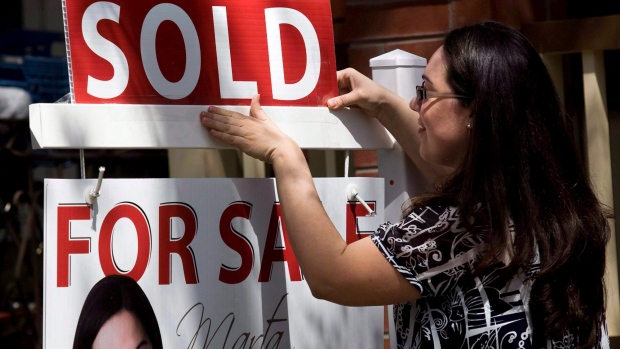Aug 19, 2016
Retail sales dip as Canadians ‘have little left’ after housing costs, economist says
, The Canadian Press

OTTAWA – Canadian consumers hunkered down in June, as retail sales slipped unexpectedly to 0.1 per cent to $44.1 billion in June from a month earlier, Statistics Canada said Friday.
By comparison, revised numbers showed that total retail sales were essentially flat in May after rising 0.8 per cent in April.
The “disappointing” retail numbers come as Canadians’ are forced to tighten their wallets amid the backdrop of rising home prices, said Sebastian Lavoie, assistant chief economist with Laurentian Bank in an interview with BNN.
“Consumers made the deliberate choice of buying homes in the last few years, so they have little left for discretionary items,” Lavoie said. “In the U.S. [we’re seeing] the strength of Americans’ wages and how well they do to spend a lot more money across the board. That’s not the case at all when you look at Canada.”
Statistics Canada found that weaker sales at food and beverage stores -- down 1.5 per cent compared to May – were a big contributor to the overall June decline in retail sales.
At these stores, beer, wine and liquor sales dropped 4.7 per cent -- the largest one-month drop in booze sales since June 2013, the agency said.
Sales at motor vehicle and parts dealers were up two per cent in June. The category received a boost from a 2.5-per-cent increase in sales at new car dealers, which saw their numbers rise for the first time in five months, Statistics Canada said.
The retails sales disappointment hit the Canadian dollar, which was recently trading near sessions lows at 77.62 U.S. cents, significantly lower than Thursday's close of 78.33 U.S. cents.
Still, economists do not expect that consumers are down for the count just yet, particularly with the additional money they are getting from the government in the form of a revamped child benefit.
"It was a forgettable month for Canadian retailing in June, but with Ottawa sending out the first of the Child Care Benefit cheques in July, there's reason to be optimistic on the second half of the year," CIBC Capital Markets economist Nick Exarhos wrote in a note to clients.
On Friday, the agency also said Canada’s annual inflation rate was 1.3 per cent in July as Canadians paid more for shelter and food but less for fuel.
This overall inflation number in the federal agency's latest consumer price index came in a little weaker than the 1.5 per cent year-over-year increase in June.
Prices climbed in most major categories compared with 12 months earlier -- with the cost of shelter and food items generating the biggest upward nudges on inflation, the report said.
For example, the index found that Canadians paid 9.8 per cent more for potatoes last month compared with July 2015, 10.3 per cent more for fresh or frozen fish and 15.6 per cent more for apples. Under the shelter category, the price of electricity was 5.4 per cent higher than the year before.
In contrast, gasoline prices fell last month by 14 per cent compared to a year earlier, fuel oil dropped 13.4 per cent and natural gas slid 10.3 per cent.
The agency's core annual inflation rate, which omits some volatile items like gasoline, stayed at 2.1 per cent last month.
By province, Statistics Canada found that Newfoundland and Labrador once again saw the highest inflation of any province last month at 3.4 per cent, which followed a 2.4-per-cent rate in June.
In July, people in Newfoundland paid 14.1 per cent more for telephone services and 26.3 per cent more for home and mortgage insurance compared to 12 months earlier.
Statistics Canada also noted that on July 1 the provincial portion of the harmonized sales tax increased in Newfoundland and New Brunswick, where consumer prices rose 2.5 per cent last month.
The economy likely contracted in the second quarter, partly due to May's wildfires in northern Alberta that forced residents to evacuate and disrupted oil production.
Although the data underscored weakness in the economy in the second quarter, analysts and policymakers still expect growth to rebound in the third quarter.
After cutting interest rates twice last year in the face of the oil price slump, the Bank of Canada is seen holding rates where they are until late 2017.
"I think the Bank of Canada continues to look through both readings," Derek Holt, economist at Scotiabank, said of the day's reports. "We knew the consumer was going to be weak overall in the second quarter."
Here are the July inflation rates for Canada's provinces and territories (previous month in brackets):
-- Newfoundland and Labrador: 3.4 per cent (2.4)
-- Prince Edward Island: 0.6 (1.1)
-- Nova Scotia: 0.8 (1.2)
-- New Brunswick: 2.5 (1.8)
-- Quebec: 0.2 (0.6)
-- Ontario: 1.5 (1.7)
-- Manitoba: 1.5 (2.1)
-- Saskatchewan: 1.1 (1.4)
-- Alberta: 0.7 (1.3)
-- British Columbia: 2.1 (2.0)
-- Whitehorse, Yukon: 0.8 (1.2)
-- Yellowknife, N.W.T.: 0.8 (0.9)
With files from BNN, Reuters


